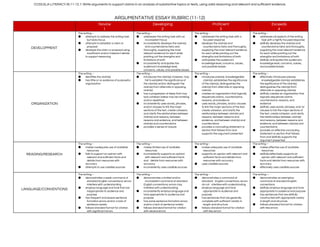Argumentative essayrubricw.1 (1)
- 1. CCSS.ELA-LITERACY.W.11-12.1:¬†Write¬†arguments¬†to¬†support¬†claims¬†in¬†an¬†analysis¬†of¬†substantive¬†topics¬†or¬†texts,¬†using¬†valid¬†reasoning¬†and¬†relevant¬†and¬†sufficient¬†evidence.¬† ARGUMENTATIVE¬†ESSAY¬†RUBRIC¬†(11-12)¬† ¬† Novice¬† 1¬† Developing¬† 2¬† Proficient¬† 3¬† Exceeds¬† 4¬†¬† DEVELOPMENT¬† ¬† ¬† The¬†writing¬†‚Äst ‚óŹ attempts¬†to¬†address¬†the¬†writing¬†task¬† ‚Ä®but¬†lacks¬†focus¬†¬† ‚óŹ attempts¬†to¬†establish¬†a¬†claim¬†or¬† ‚Ä®proposal¬†¬† ‚óŹ develops¬†the¬†claim¬†or¬†proposal¬†using¬† ‚Ä®insufficient¬†and/or¬†irrelevant¬†details¬† to¬†support¬†reasoning¬†¬† The¬†writing¬†‚Äst ‚óŹ addresses¬†the¬†writing¬†task¬†with¬†an¬† ‚Ä®inconsistent¬†focus¬†¬† ‚óŹ inconsistently¬†develops¬†the¬†claim(s)¬† ‚Ä®and¬†counterclaims¬†fairly¬†and¬† thoroughly,¬†supplying¬†the¬†most¬† relevant¬†evidence¬†for¬†each¬†while¬† pointing¬†out¬†the¬†strengths¬†and¬† limitations¬†of¬†both¬†¬† ‚óŹ inconsistently¬†anticipates¬†the¬† audience‚Äôs¬†knowledge¬†level,¬† concerns,¬†values,¬†and¬†possible¬†biases¬†¬† The¬†writing¬†‚Äst ‚óŹ addresses¬†the¬†writing¬†task¬†with¬†a¬† ‚Ä®focused¬†response¬†¬† ‚óŹ develops¬†the¬†claim(s)¬†and¬† ‚Ä®counterclaims¬†fairly¬†and¬†thoroughly,¬† supplying¬†the¬†most¬†relevant¬†evidence¬† for¬†each¬†while¬†pointing¬†out¬†the¬† strengths¬†and¬†limitations¬†of¬†both¬†¬† ‚óŹ anticipates¬†the¬†audience‚Äôs¬† knowledge¬†level,¬†concerns,¬†values,¬† and¬†possible¬†biases¬†¬† The¬†writing¬†‚Äst ‚óŹ addresses¬†all¬†aspects¬†of¬†the¬†writing¬† ‚Ä®task¬†with¬†a¬†tightly¬†focused¬†response¬†¬† ‚óŹ skillfully¬†develops¬†the¬†claim(s)¬†and¬† ‚Ä®counterclaims¬†fairly¬†and¬†thoroughly,¬† supplying¬†the¬†most¬†relevant¬†evidence¬† for¬†each¬†while¬†pointing¬†out¬†the¬† strengths¬†and¬†limitations¬†of¬†both¬†¬† ‚óŹ skillfully¬†anticipates¬†the¬†audience‚Äôs¬† knowledge¬†level,¬†concerns,¬†values,¬† and¬†possible¬†biases¬†¬† ORGANIZATION¬† ¬† ¬† The¬†writing¬†‚Äď‚Ä®¬† ‚óŹ identifies¬†the¬†claim(s)‚Ä®¬† ‚óŹ has¬†little¬†or¬†no¬†evidence¬†of¬†purposeful¬† organization¬† The¬†writing¬†‚Äst ‚óŹ introduces¬†the¬†claim(s);¬†however,¬†may¬† ‚Ä®fail¬†to¬†establish¬†the¬†significance¬†of¬† the¬†claim(s)¬†and/or¬†distinguish¬†the¬† claim(s)¬†from¬†alternate¬†or¬†opposing¬† claim(s)¬†¬† ‚óŹ has¬†a¬†progression¬†of¬†ideas¬†that¬†may¬† lack¬†cohesion¬†(ideas¬†may¬†be¬†rambling¬† and/or¬†repetitive)¬†¬† ‚óŹ inconsistently¬†uses¬†words,¬†phrases,¬† and/or¬†clauses¬†to¬†link¬†the¬†major¬† sections¬†of¬†the¬†text,¬†create¬†cohesion,¬† and¬†clarify¬†the¬†relationships¬†between¬† claim(s)¬†and¬†reasons,¬†between¬† reasons¬†and¬†evidence,¬†and¬†between¬† claim(s)¬†and¬†counterclaims¬†¬† ‚óŹ provides¬†a¬†sense¬†of¬†closure¬†¬† The¬†writing¬†‚Äst ‚óŹ introduces¬†precise,¬†knowledgeable¬† ‚Ä®claim(s);¬†establishes¬†the¬†significance¬† of¬†the¬†claim(s);¬†distinguishes¬†the¬† claim(s)¬†from¬†alternate¬†or¬†opposing¬† claim(s)¬†¬† ‚óŹ creates¬†an¬†organization¬†that¬†logically¬† sequences¬†claims,¬†counterclaims,¬† reasons,¬†and¬†evidence¬†¬† ‚óŹ uses¬†words,¬†phrases,¬†and/or¬†clauses¬† to¬†link¬†the¬†major¬†sections¬†of¬†the¬†text,¬† create¬†cohesion,¬†and¬†clarify¬†the¬† relationships¬†between¬†claim(s)¬†and¬† reasons,¬†between¬†reasons¬†and¬† evidence,¬†and¬†between¬†claim(s)¬†and¬† counterclaims¬†¬† ‚óŹ provides¬†a¬†concluding¬†statement¬†or¬† section¬†that¬†follows¬†from¬†and¬† supports¬†the¬†argument¬†presented¬† The¬†writing¬†‚Äst ‚óŹ effectively¬†introduces¬†precise,¬† ‚Ä®knowledgeable¬†claim(s);¬†establishes¬† the¬†significance¬†of¬†the¬†claim(s);¬† distinguishes¬†the¬†claim(s)¬†from¬† alternate¬†or¬†opposing¬†claim(s)¬†¬† ‚óŹ skillfully¬†creates¬†an¬†organization¬†that¬† logically¬†sequences¬†claims,¬† counterclaims,¬†reasons,¬†and¬† evidence¬†¬† ‚óŹ skillfully¬†uses¬†words,¬†phrases,¬†and¬†/or¬† clauses¬†to¬†link¬†the¬†major¬†sections¬†of¬† the¬†text,¬†create¬†cohesion,¬†and¬†clarify¬† the¬†relationships¬†between¬†claim(s)¬† and¬†reasons,¬†between¬†reasons¬†and¬† evidence,¬†and¬†between¬†claim(s)¬†and¬† counterclaims¬†¬† ‚óŹ provides¬†an¬†effective¬†concluding¬† statement¬†or¬†section¬†that¬†follows¬† from¬†and¬†skillfully¬†supports¬†the¬† argument¬†presented¬†¬† READING/RESEARCH¬† ¬† ¬† The¬†writing¬†‚Äst ‚óŹ makes¬†inadequate¬†use¬†of¬†available¬† ‚Ä®resources¬†¬† ‚óŹ fails¬†to¬†support¬†an¬†opinion¬†with¬† ‚Ä®relevant¬†and¬†sufficient¬†facts¬†and¬† ‚Ä®details¬†from¬†resources¬†with¬† accuracy¬†¬† ‚óŹ attempts¬†to¬†use¬†credible¬†sources¬† The¬†writing¬†‚Äst ‚óŹ makes¬†limited¬†use¬†of¬†available¬† ‚Ä®resources¬†¬† ‚óŹ inconsistently¬†supports¬†an¬†opinion¬† ‚Ä®with¬†relevant¬†and¬†sufficient¬†facts¬† and¬†‚Ä®details¬†from¬†resources¬†with¬† accuracy¬†¬† ‚óŹ inconsistently¬†uses¬†credible¬†sources¬† The¬†writing¬†‚Äst ‚óŹ makes¬†adequate¬†use¬†of¬†available¬† ‚Ä®resources¬†¬† ‚óŹ supports¬†an¬†opinion¬†with¬†relevant¬†and¬† ‚Ä®sufficient¬†facts¬†and¬†details¬†from¬† ‚Ä®resources¬†with¬†accuracy¬†¬† ‚óŹ uses¬†credible¬†sources¬† The¬†writing¬†‚Äst ‚óŹ makes¬†effective¬†use¬†of¬†available¬† ‚Ä®resources¬†¬† ‚óŹ skillfully/effectively¬†supports¬†an¬† ‚Ä®opinion¬†with¬†relevant¬†and¬†sufficient¬† facts¬†and¬†details¬†from¬†resources¬†with¬† accuracy¬†¬† ‚óŹ effectively¬†uses¬†credible¬†sources¬† LANGUAGE/CONVENTIONS¬† ¬† ¬† The¬†writing¬†‚Äst ‚óŹ demonstrates¬†a¬†weak¬†command¬†of¬† ‚Ä®standard¬†English¬†conventions;¬†errors¬† ‚Ä®interfere¬†with¬†understanding¬†¬† ‚óŹ employs¬†language¬†and¬†tone¬†that¬†are¬† ‚Ä®inappropriate¬†to¬†audience¬†and¬† ‚Ä®purpose¬†¬† ‚óŹ has¬†frequent¬†and¬†severe¬†sentence¬† ‚Ä®formation¬†errors¬†and/or¬†a¬†lack¬†of¬† ‚Ä®sentence¬†variety¬†¬† ‚óŹ follows¬†standard¬†format¬†for¬†citation¬† ‚Ä®with¬†significant¬†errors¬† The¬†writing¬†‚Äst ‚óŹ demonstrates¬†a¬†limited¬†and/or¬† ‚Ä®inconsistent¬†command¬†of¬†standard¬† English¬†conventions;¬†errors¬†may¬† interfere¬†with¬†understanding¬†¬† ‚óŹ inconsistently¬†employs¬†language¬†and¬† tone¬†appropriate¬†to¬†audience¬†and¬† purpose¬†¬† ‚óŹ has¬†some¬†sentence¬†formation¬†errors¬† and/or¬†a¬†lack¬†of¬†sentence¬†variety¬†¬† ‚óŹ follows¬†standard¬†format¬†for¬†citation¬† with¬†several¬†errors¬† The¬†writing¬†‚Äst ‚óŹ demonstrates¬†a¬†command¬†of¬† standard¬†‚Ä®English¬†conventions;¬†errors¬† do¬†not¬†‚Ä®interfere¬†with¬†understanding¬†¬† ‚óŹ employs¬†language¬†and¬†tone¬† ‚Ä®appropriate¬†to¬†audience¬†and¬† purpose¬†¬† ‚óŹ has¬†sentences¬†that¬†are¬†generally¬† complete¬†with¬†sufficient¬†variety¬†in¬† ‚Ä®length¬†and¬†structure¬†¬† ‚óŹ follows¬†standard¬†format¬†for¬†citation¬† ‚Ä®with¬†few¬†errors¬† The¬†writing‚ÄĒ¬† ‚óŹ demonstrates¬†an¬†exemplary¬† command¬†of¬†standard¬†English¬† conventions¬† ‚óŹ skillfully¬†employs¬†language¬†and¬†tone¬† appropriate¬†to¬†audience¬†and¬†purpose¬† ‚óŹ has¬†sentences¬†that¬†are¬†skillfully¬† constructed¬†with¬†appropriate¬†variety¬† in¬†length¬†and¬†structure¬† ‚óŹ follows¬†standard¬†format¬†for¬†citation¬† with¬†few¬†errors¬† ¬† ¬† ¬†

